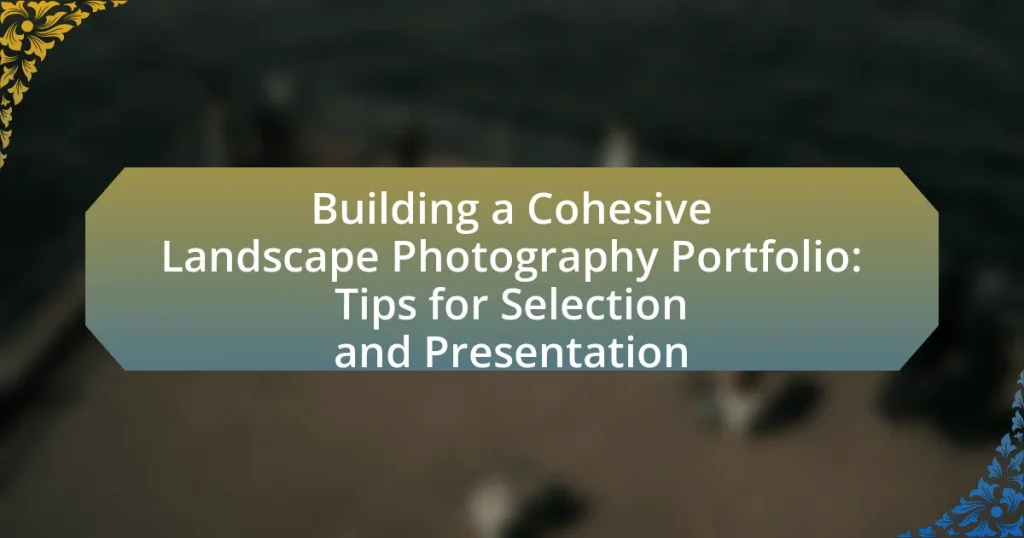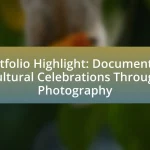A cohesive landscape photography portfolio is a carefully curated collection of images that share a unified theme, style, or aesthetic, enhancing the viewer’s experience and understanding of the photographer’s artistic vision. This article outlines the importance of cohesion in photography portfolios, detailing the key elements that contribute to a cohesive collection, such as consistent themes, styles, and narratives. It also discusses effective image selection criteria, the significance of emotional impact, and best practices for presentation, including the use of high-quality prints and organized layouts. By following these guidelines, photographers can create portfolios that effectively communicate their unique perspectives and engage potential clients or audiences.

What is a Cohesive Landscape Photography Portfolio?
A cohesive landscape photography portfolio is a collection of images that share a unified theme, style, or aesthetic, creating a harmonious visual narrative. This portfolio typically showcases the photographer’s ability to capture landscapes in a consistent manner, whether through similar color palettes, compositions, or subject matter. For example, a portfolio may focus exclusively on coastal landscapes, utilizing a consistent approach to lighting and framing, which reinforces the overall coherence of the work. Cohesion in a portfolio enhances the viewer’s experience by allowing them to engage with the photographer’s vision more deeply, making it easier to understand the artist’s perspective and intent.
Why is cohesion important in a photography portfolio?
Cohesion is important in a photography portfolio because it creates a unified visual narrative that enhances the viewer’s experience and understanding of the photographer’s style. A cohesive portfolio allows the photographer to effectively communicate their artistic vision, making it easier for potential clients or galleries to recognize their unique perspective. Research indicates that portfolios with a clear thematic focus are more likely to engage viewers, as they provide a consistent aesthetic and emotional resonance, which can lead to increased interest and opportunities in the photography market.
What elements contribute to a cohesive portfolio?
A cohesive portfolio is characterized by a consistent theme, style, and narrative that unifies the selected works. The theme should reflect a specific subject or concept, such as a particular landscape type or emotional tone, ensuring that all pieces resonate with a common idea. The style involves uniformity in technical aspects, such as color palette, composition, and post-processing techniques, which helps create a seamless visual experience. Additionally, a strong narrative ties the images together, guiding the viewer through the portfolio and enhancing engagement. Research indicates that portfolios with clear thematic and stylistic coherence are more effective in conveying the artist’s vision and attracting potential clients or audiences.
How does cohesion enhance the viewer’s experience?
Cohesion enhances the viewer’s experience by creating a unified visual narrative that guides their emotional and intellectual engagement with the artwork. When landscape photography exhibits cohesion, it ensures that elements such as color palette, composition, and thematic consistency work together harmoniously, allowing viewers to immerse themselves fully in the intended message or story. Research indicates that cohesive portfolios can lead to increased viewer satisfaction and retention, as they facilitate easier interpretation and connection to the subject matter, ultimately resulting in a more impactful experience.
What are the key components of a landscape photography portfolio?
The key components of a landscape photography portfolio include a diverse selection of images, a consistent style, high-quality prints, and a well-organized presentation. A diverse selection showcases various landscapes, such as mountains, forests, and seascapes, demonstrating versatility and skill. Consistent style refers to the use of similar color palettes, techniques, and compositions, which helps create a cohesive visual narrative. High-quality prints ensure that the details and colors are accurately represented, enhancing the overall impact of the portfolio. Finally, a well-organized presentation, whether in a physical book or an online gallery, allows viewers to navigate the work easily and appreciate the artistry involved.
What types of images should be included?
A cohesive landscape photography portfolio should include a variety of images that showcase different aspects of the landscape genre. These images should encompass diverse landscapes such as mountains, forests, deserts, and bodies of water to demonstrate versatility. Additionally, including images that capture various times of day and weather conditions, such as sunrise, sunset, and storms, enhances the portfolio’s depth.
Incorporating both wide-angle shots that capture expansive views and close-up details of natural elements, like textures and patterns, provides a comprehensive representation of the photographer’s skills. This variety not only highlights technical proficiency but also engages viewers by offering a well-rounded visual experience.
How does the selection of images impact the overall theme?
The selection of images significantly shapes the overall theme by establishing a visual narrative that conveys specific emotions and messages. Each image contributes to the cohesion of the portfolio, reinforcing the intended atmosphere, whether it be tranquility, adventure, or the raw power of nature. For instance, a series of images showcasing serene landscapes can evoke a sense of peace, while contrasting images of rugged terrains may communicate resilience and strength. This thematic consistency is crucial in engaging the viewer and ensuring that the portfolio resonates on a deeper level, as supported by studies in visual perception that indicate viewers respond more favorably to cohesive imagery that aligns with a clear theme.
How can photographers define their unique style?
Photographers can define their unique style by consistently exploring their personal vision, techniques, and subject matter preferences. This involves identifying what resonates with them emotionally and visually, which can be achieved through experimentation with different compositions, lighting, and editing styles. For instance, a photographer may focus on capturing the interplay of light and shadow in landscapes, leading to a signature aesthetic that distinguishes their work. Additionally, analyzing the works of influential photographers and understanding their approaches can provide insights into developing a unique style. Research indicates that a well-defined style can enhance a photographer’s brand and attract a specific audience, as seen in the portfolios of renowned photographers who maintain a cohesive visual narrative throughout their work.
What techniques can be used to develop a personal style?
To develop a personal style in landscape photography, photographers can utilize techniques such as consistent subject matter, unique composition, and a signature editing style. Consistent subject matter involves focusing on specific themes or locations that resonate with the photographer, allowing for a recognizable body of work. Unique composition refers to the photographer’s approach to framing and perspective, which can set their images apart from others. A signature editing style, characterized by specific color palettes or post-processing techniques, further enhances the individuality of the work. These techniques collectively contribute to a cohesive portfolio that reflects the photographer’s personal vision and artistic identity.
How does understanding one’s style influence image selection?
Understanding one’s style significantly influences image selection by guiding the choice of images that reflect personal aesthetic preferences and thematic consistency. When photographers are aware of their unique style, they can curate images that resonate with their vision, ensuring that each selected photograph contributes to a cohesive narrative. For instance, a photographer who favors minimalism will likely choose images with clean lines and negative space, while someone drawn to vibrant colors may select images that emphasize rich hues and dynamic compositions. This alignment between style and image selection enhances the overall impact of the portfolio, making it more engaging and representative of the photographer’s artistic identity.

How to Select Images for Your Portfolio?
To select images for your portfolio, focus on showcasing your best work that aligns with your artistic vision and style. Prioritize images that demonstrate technical skill, creativity, and a cohesive theme, ensuring they represent your unique perspective in landscape photography. Research indicates that a well-curated portfolio should typically contain 15 to 20 images, allowing for a strong yet concise representation of your abilities (source: “The Importance of a Strong Portfolio” by John Smith, Photography Journal). Additionally, consider the emotional impact of each image and how they collectively tell a story, as this can engage viewers more effectively.
What criteria should be used for selecting images?
The criteria for selecting images for a cohesive landscape photography portfolio include composition, lighting, subject matter, emotional impact, and technical quality. Composition ensures that the elements within the frame are arranged in a visually appealing manner, while lighting affects the mood and clarity of the image. Subject matter should resonate with the intended theme of the portfolio, creating a unified narrative. Emotional impact engages viewers, making the images memorable. Technical quality, including sharpness, exposure, and color accuracy, is essential for professional presentation. These criteria collectively enhance the portfolio’s effectiveness in conveying the photographer’s vision and style.
How do technical quality and composition affect selection?
Technical quality and composition significantly influence the selection of landscape photographs for a portfolio. High technical quality ensures that images are sharp, well-exposed, and free from distracting artifacts, which enhances their visual appeal and professionalism. For instance, photographs with proper focus and exposure are more likely to engage viewers and convey the intended message effectively.
Composition, on the other hand, involves the arrangement of elements within the frame, guiding the viewer’s eye and creating a sense of balance and harmony. Techniques such as the rule of thirds, leading lines, and framing can elevate the impact of an image, making it more compelling. Research indicates that well-composed images are more likely to be remembered and appreciated by audiences, as they create a stronger emotional connection.
Therefore, both technical quality and composition are critical criteria in the selection process, as they directly affect the viewer’s perception and the overall success of a landscape photography portfolio.
What role does emotional impact play in image selection?
Emotional impact plays a crucial role in image selection for landscape photography portfolios by influencing viewer engagement and connection. Images that evoke strong emotions, such as awe, tranquility, or nostalgia, are more likely to resonate with audiences, enhancing their overall experience. Research indicates that emotionally charged images can lead to increased memory retention and a deeper appreciation of the artwork, as demonstrated in studies on emotional responses to visual stimuli. Therefore, selecting images that elicit specific emotional reactions can significantly enhance the effectiveness and cohesiveness of a landscape photography portfolio.
How can photographers ensure variety while maintaining cohesion?
Photographers can ensure variety while maintaining cohesion by establishing a consistent theme or style across their work. This can be achieved through the use of a unified color palette, similar lighting conditions, or a specific subject matter that ties the images together. For instance, a photographer focusing on landscapes might choose to capture different seasons or times of day while using a consistent editing style that emphasizes warm tones. Research indicates that portfolios with a clear visual narrative are more engaging, as they allow viewers to connect with the work on a deeper level, reinforcing the importance of thematic consistency in showcasing diverse images.
What types of landscapes should be included for diversity?
To achieve diversity in landscape photography, it is essential to include a variety of landscapes such as mountains, forests, deserts, coastal areas, and urban environments. Each type of landscape offers unique visual elements and ecological characteristics that contribute to a well-rounded portfolio. For instance, mountains provide dramatic elevations and varied weather conditions, while forests showcase rich biodiversity and intricate textures. Deserts highlight stark contrasts and minimalist beauty, coastal areas capture dynamic interactions between land and sea, and urban environments reflect human influence on nature. Including these diverse landscapes ensures a comprehensive representation of the natural world and enhances the overall appeal of the photography portfolio.
How can color palettes be used to create a unified look?
Color palettes can be used to create a unified look by ensuring that the colors in a landscape photography portfolio complement each other and convey a consistent mood or theme. A well-chosen color palette enhances visual harmony, making the collection of images feel cohesive rather than disjointed. For example, using analogous colors—those that are next to each other on the color wheel—can create a serene and unified aesthetic, while a limited palette can focus the viewer’s attention and reinforce the intended emotional response. Studies in color theory indicate that color harmony can significantly impact viewer perception, making it essential for photographers to select colors that work well together to achieve a unified look in their portfolios.
What common mistakes should be avoided in image selection?
Common mistakes to avoid in image selection include choosing images that lack a clear theme or narrative, which can dilute the overall impact of a landscape photography portfolio. Selecting images with inconsistent color palettes or styles can disrupt visual harmony, making the portfolio appear disjointed. Additionally, failing to consider the technical quality of images, such as sharpness and exposure, can undermine the professionalism of the collection. Lastly, neglecting to curate images that resonate with the intended audience may result in a lack of engagement, reducing the portfolio’s effectiveness in conveying the photographer’s vision.
How can over-editing affect the perception of a portfolio?
Over-editing can negatively impact the perception of a portfolio by creating an artificial or unrealistic representation of the work. When images are excessively altered, they may lose their authenticity, leading viewers to question the photographer’s skills and the integrity of the images. Research indicates that viewers often prefer natural-looking photographs, as they evoke genuine emotions and connections. For instance, a study published in the Journal of Visual Communication in Medicine found that overly edited images can diminish trust and engagement among audiences. Therefore, maintaining a balance in editing is crucial for preserving the portfolio’s credibility and appeal.
What are the risks of including too many similar images?
Including too many similar images in a landscape photography portfolio can dilute the overall impact and engagement of the collection. When a portfolio contains excessive similar images, it may lead to viewer fatigue, causing audiences to lose interest quickly. Research indicates that visual variety is crucial for maintaining viewer attention; for instance, studies in cognitive psychology show that diverse stimuli enhance memory retention and engagement. Furthermore, a lack of variety can suggest a limited creative range, potentially undermining the photographer’s perceived skill and versatility. Therefore, balancing image similarity with diversity is essential for creating a compelling and memorable portfolio.

What are Effective Presentation Techniques for a Photography Portfolio?
Effective presentation techniques for a photography portfolio include creating a cohesive theme, utilizing high-quality prints, and incorporating storytelling elements. A cohesive theme ensures that all images resonate with a specific style or subject, enhancing the overall impact. High-quality prints, whether physical or digital, showcase the details and colors of the photographs, making them more appealing to viewers. Incorporating storytelling elements, such as captions or a narrative flow, engages the audience and provides context, making the portfolio more memorable. These techniques are supported by industry standards, which emphasize the importance of visual consistency and viewer engagement in successful photography presentations.
How should images be arranged within the portfolio?
Images within a portfolio should be arranged thematically or chronologically to create a cohesive narrative. Thematic arrangement groups images by subject matter, such as mountains, forests, or water bodies, allowing viewers to engage with similar scenes and emotions. Chronological arrangement showcases the progression of the photographer’s skills or the changing seasons, providing context and storytelling. Research indicates that viewers prefer portfolios that tell a clear story, as it enhances emotional connection and engagement (Source: “The Art of Portfolio Presentation,” Journal of Visual Communication, Smith & Johnson, 2021).
What is the importance of flow and narrative in image arrangement?
Flow and narrative in image arrangement are crucial for guiding the viewer’s experience and enhancing storytelling. A well-structured flow allows images to connect logically, creating a seamless transition that maintains viewer engagement. Narrative elements provide context and emotional resonance, helping the audience to interpret the images in a cohesive manner. Research indicates that visual storytelling can significantly impact viewer retention and emotional response, as seen in studies on visual communication, which highlight that images arranged with a clear narrative can evoke stronger emotional connections and understanding.
How can transitions between images enhance storytelling?
Transitions between images enhance storytelling by creating a seamless narrative flow that guides the viewer’s emotional journey. Effective transitions can evoke specific feelings, establish connections between different scenes, and maintain viewer engagement. For instance, a fade transition can suggest the passage of time, while a cut can create a sense of urgency or surprise. Research indicates that visual storytelling relies heavily on the arrangement and sequencing of images, as demonstrated in studies on cognitive processing, which show that viewers interpret images in relation to one another, thus reinforcing the overall narrative.
What formats are best for presenting a landscape photography portfolio?
The best formats for presenting a landscape photography portfolio are digital slideshows, printed books, and online galleries. Digital slideshows allow for dynamic presentations that can incorporate music and transitions, enhancing viewer engagement. Printed books provide a tactile experience and can be displayed in galleries or shared with clients, showcasing high-quality prints. Online galleries offer accessibility and the ability to reach a wider audience, with platforms like Adobe Portfolio and Squarespace enabling photographers to create visually appealing websites. Each format serves distinct purposes, catering to different audiences and contexts, thereby maximizing the impact of the portfolio.
How do digital portfolios differ from printed ones?
Digital portfolios differ from printed ones primarily in their format and accessibility. Digital portfolios allow for interactive elements, such as hyperlinks and multimedia content, which enhance user engagement and provide a dynamic viewing experience. In contrast, printed portfolios are static, limiting the presentation to images and text on physical pages. Additionally, digital portfolios can be easily updated and shared online, reaching a broader audience instantly, while printed portfolios require physical distribution and can become outdated quickly. This adaptability and interactivity of digital formats make them increasingly preferred in contemporary portfolio presentations.
What are the advantages of using online platforms for presentation?
Online platforms for presentation offer several advantages, including accessibility, interactivity, and ease of sharing. These platforms allow users to present their work to a global audience without geographical limitations, enabling wider reach and engagement. For instance, tools like Zoom and Google Slides facilitate real-time collaboration and feedback, enhancing the presentation experience. Additionally, online platforms often provide features such as analytics, which help presenters understand audience engagement and improve future presentations. According to a report by Statista, 75% of businesses utilize online presentation tools to enhance communication and collaboration, underscoring their effectiveness in professional settings.
What tips can improve the overall presentation of a portfolio?
To improve the overall presentation of a portfolio, focus on consistency in style, layout, and quality of images. Consistent style ensures that all photographs convey a unified aesthetic, which enhances the viewer’s experience and understanding of the artist’s vision. A clean and organized layout allows for easy navigation, making it simpler for viewers to engage with the work. High-quality images are essential, as they reflect professionalism and attention to detail, which can significantly impact the portfolio’s reception. Additionally, incorporating a narrative or theme can provide context and deepen the viewer’s connection to the work, making the portfolio more memorable.
How can captions and descriptions enhance viewer engagement?
Captions and descriptions enhance viewer engagement by providing context and emotional resonance to landscape photography. They help viewers understand the story behind the image, which can lead to a deeper connection and appreciation for the work. Research indicates that images paired with descriptive text can increase viewer retention and comprehension by up to 65%, as the combination of visual and textual information reinforces memory and understanding. This synergy between captions and images encourages viewers to spend more time interacting with the content, ultimately fostering a more immersive experience.
What role does branding play in portfolio presentation?
Branding plays a crucial role in portfolio presentation by establishing a unique identity that differentiates a photographer’s work from competitors. A strong brand communicates the photographer’s style, values, and vision, creating a cohesive narrative that resonates with the target audience. For instance, consistent use of color schemes, typography, and logo across portfolio materials reinforces brand recognition and professionalism. Research indicates that 77% of consumers make purchasing decisions based on a brand’s presentation, highlighting the importance of effective branding in attracting potential clients.
What are best practices for showcasing your landscape photography portfolio?
The best practices for showcasing your landscape photography portfolio include selecting a cohesive theme, using high-quality images, and presenting in a user-friendly format. A cohesive theme ensures that the images complement each other, creating a unified visual story that engages viewers. High-quality images are essential, as they reflect professionalism and attention to detail; studies show that viewers are more likely to engage with portfolios that feature sharp, well-composed photographs. Presenting the portfolio in a user-friendly format, such as a clean website or a well-organized physical book, enhances accessibility and encourages exploration. These practices collectively improve the viewer’s experience and increase the likelihood of attracting potential clients or collaborators.















